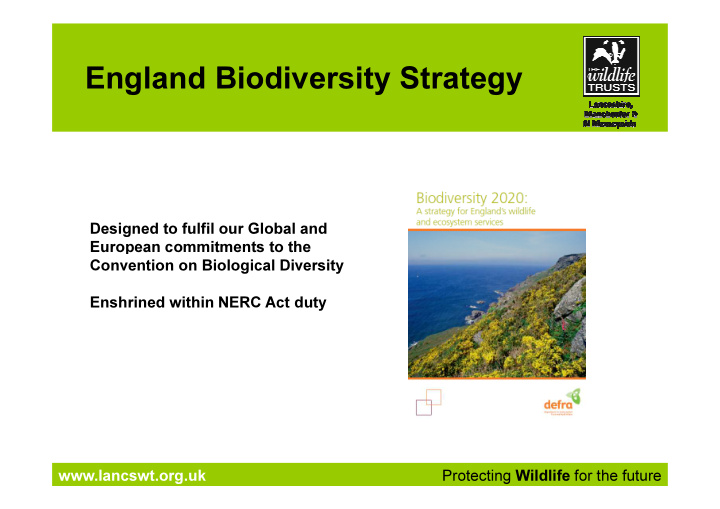



England Biodiversity Strategy Designed to fulfil our Global and European commitments to the Convention on Biological Diversity Enshrined within NERC Act duty www.lancswt.org.uk Protecting Wildlife for the future
Why a new strategy? • Failure to meet 2010 targets to halt the loss of biodiversity – new 2020 targets set at Nagoya Biodiversity Summit October 2010 • Review of this failure suggest that the English nature conservation approach too piecemeal – integration needed and landscape scale. • Greater understanding of the value of nature and the services it provides. • Climate and population change will increase pressures on wildlife. www.lancswt.org.uk Protecting Wildlife for the future
National Ecosystem Assessment Study June 2011 ‘The natural world, its biodiversity and its constituent ecosystems are critically important to our well-being and economic prosperity, but are consistently undervalued in conventional economic analyses and decision making.‘ For example, the report calculated: For example, the report calculated: • the value of pollinators to UK agriculture of £430m p.a. • UK green spaces worth at least £30bn a year in health and welfare • Flood control and storm buffering value of our wetland habitats is worth £366m a year www.lancswt.org.uk Protecting Wildlife for the future
‘Making space for nature’: a review of England's wildlife sites. Chaired by Sir John Lawton September 2010 Terms of reference : • Examine evidence on the extent to which England’s collection of wildlife sites represents a coherent and resilient ecological network capable of adapting to the challenge of climate change and other pressures challenge of climate change and other pressures (looked at 2 O C temp. rise) • Examine the evidence base to assess whether a more inter-connected network would be more effective today and in the future and, if so, how this could be delivered • Taking account of the ecological, economic and social costs and benefits, make costed and prioritised recommendations www.lancswt.org.uk Protecting Wildlife for the future
The Lawton Review called for a step change in the way nature conservation is delivered. Our wildlife resource is fragmented and conservation efforts piecemeal Sets out principles to guide adaptation to climate change www.lancswt.org.uk Protecting Wildlife for the future
A more robust landscape ‘Making Space for Nature’ September 2010 www.lancswt.org.uk Protecting Wildlife for the future
Natural Environment White Paper June 2011 ‘Nature is sometimes taken for granted and undervalued. But people cannot flourish without the benefits and services our natural environment provides. A healthy, properly functioning natural environment is the foundation of sustained economic growth, prospering communities and personal wellbeing.’ Key proposals; An ecosystem services approach at the heart of decision making Landscape scale Multi-partner and multi-thematic working www.lancswt.org.uk Protecting Wildlife for the future
England Biodiversity Strategy August 2011 The vision is�. to halt overall biodiversity loss, support healthy well-functioning ecosystems and establish coherent ecological networks, with more and better places for nature for the benefit of wildlife and people. www.lancswt.org.uk Protecting Wildlife for the future
England Biodiversity Strategy August 2011 The 5 key elements of the new strategy are: • a more integrated approach across all sectors • large-scale approach to conservation on land and at sea • putting people at the heart of biodiversity policy • reducing environmental pressures • improving our knowledge Action plan to be published in the spring www.lancswt.org.uk Protecting Wildlife for the future
The Strategy sees delivery being organised locally through Local Nature Partnerships (LNP) • 50 LNPs nationally • Lancashire was successful in applying for funding to help move towards LNP status • “LNP to mirror Local Enterprise Partnerships (LEPs) and, Government explicitly “encourages LEPs and Local Nature Partnerships to work together to forge strong links that capture the value of nature.” • Work to deliver landscape-scale action. www.lancswt.org.uk Protecting Wildlife for the future
Nature Improvement Areas A £7.5million competition for partnerships, primarily LNPs, to bid for funding to develop one of 12 initial Nature Improvement Areas (NIAs). They will be: “ large, discrete areas that will deliver a step change in nature conservation, where a local partnership has a shared vision for their natural environment.” Three NIAs have been submitted in Lancashire: Morecambe Bay Partnership Area; Forest of Bowland; South Pennines www.lancswt.org.uk Protecting Wildlife for the future
The way forward The proposal is to develop a Local Nature Partnership for Lancashire and to work together to deliver the Biodiversity Strategy. www.lancswt.org.uk Protecting Wildlife for the future
Recommend
More recommend